When America Received a Message from the Future
The 1939 New York World's Fair promised a dream future unlike any other, but the consequences of its vision were buried beneath the spectacle.
It can be said that much of modern America was born in 1939. That year, the New York City World’s Fair officially began. The mega-event would go on for two seasons (‘39 and ‘40) and break records, exciting audiences by promising a glimpse into the “world of tomorrow.”
The Fair condensed many ideas and developments that would come to define the coming era, famously called the “American Century” by media magnate Henry Luce. Those who attended described experiencing a feeling of awe and being overloaded with newness. The exhibits were futuristic, optimistic, and unyielding in their belief in progress and technology.
If you were there, something was bound to strike you — mechanized farms, car production lines, steelworks, home heating, glassmaking furnaces, dioramas of future megacities, long-distance phone lines, amusement parks, motorcycle shows, electrical appliances, diesel-powered locomotives, industrial plastics, nutritional science, mechanized milk production (with actual cows), nylon clothing, high-end fashion houses, watchmaking, rare jewels, orchestral performances, amusement parks, atomic science presentations, the first computer game, the first science fiction convention, over 500 world-renowned paintings and sculptures, an exhibit for each of the world’s leading nations (and for twenty-three U.S. states), and on and on.1
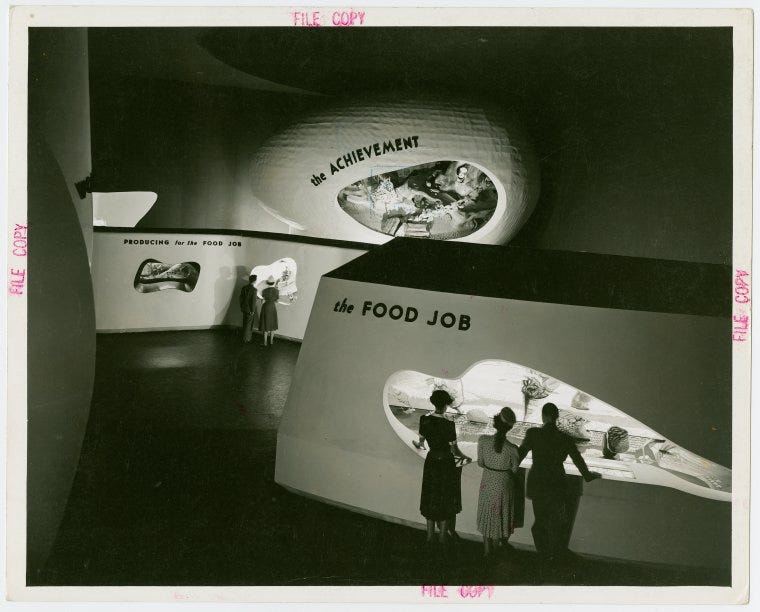
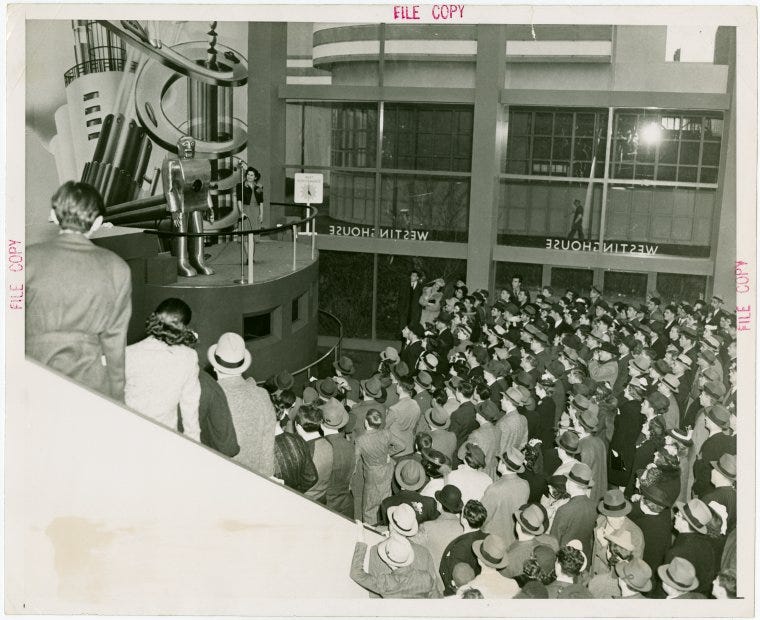
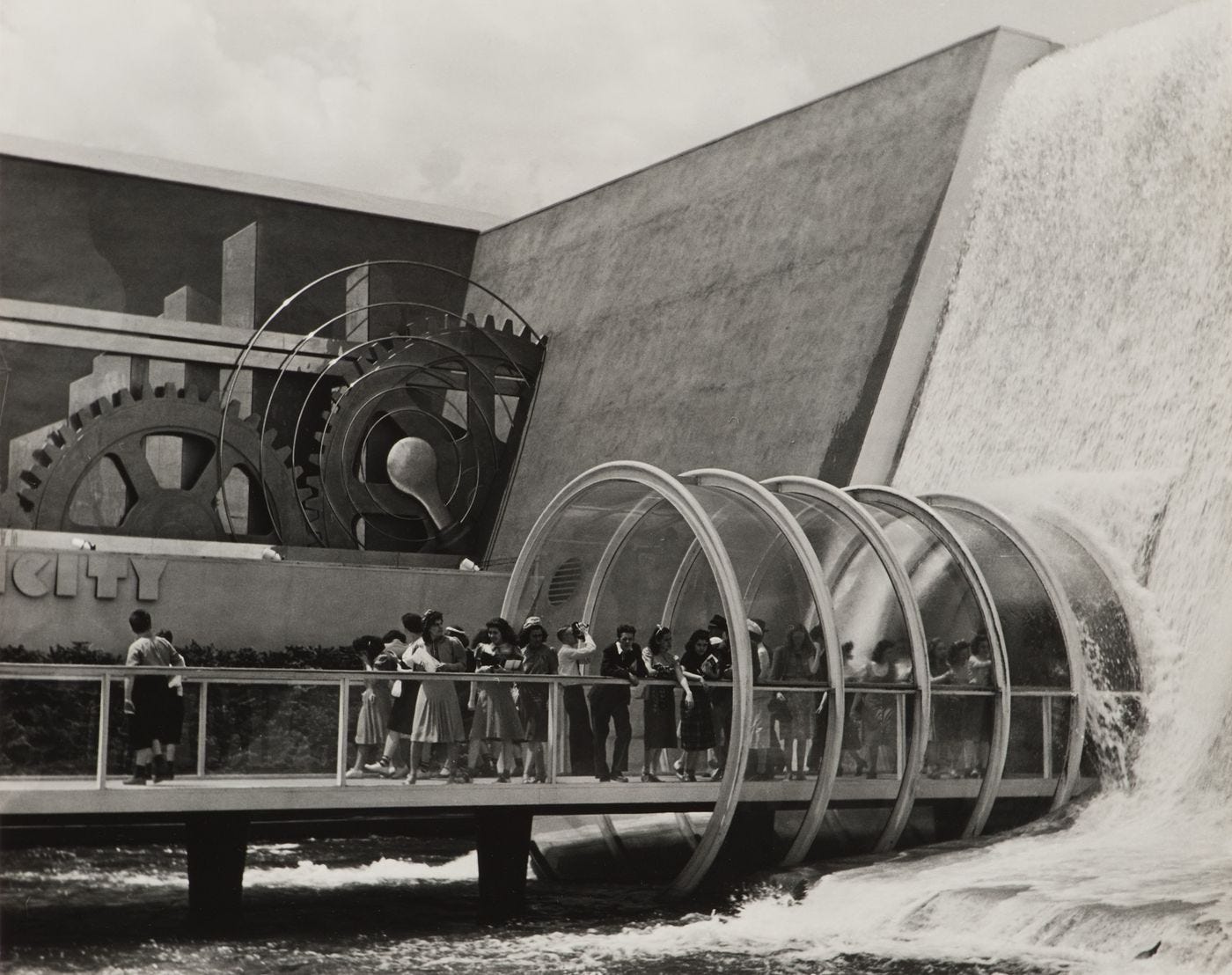
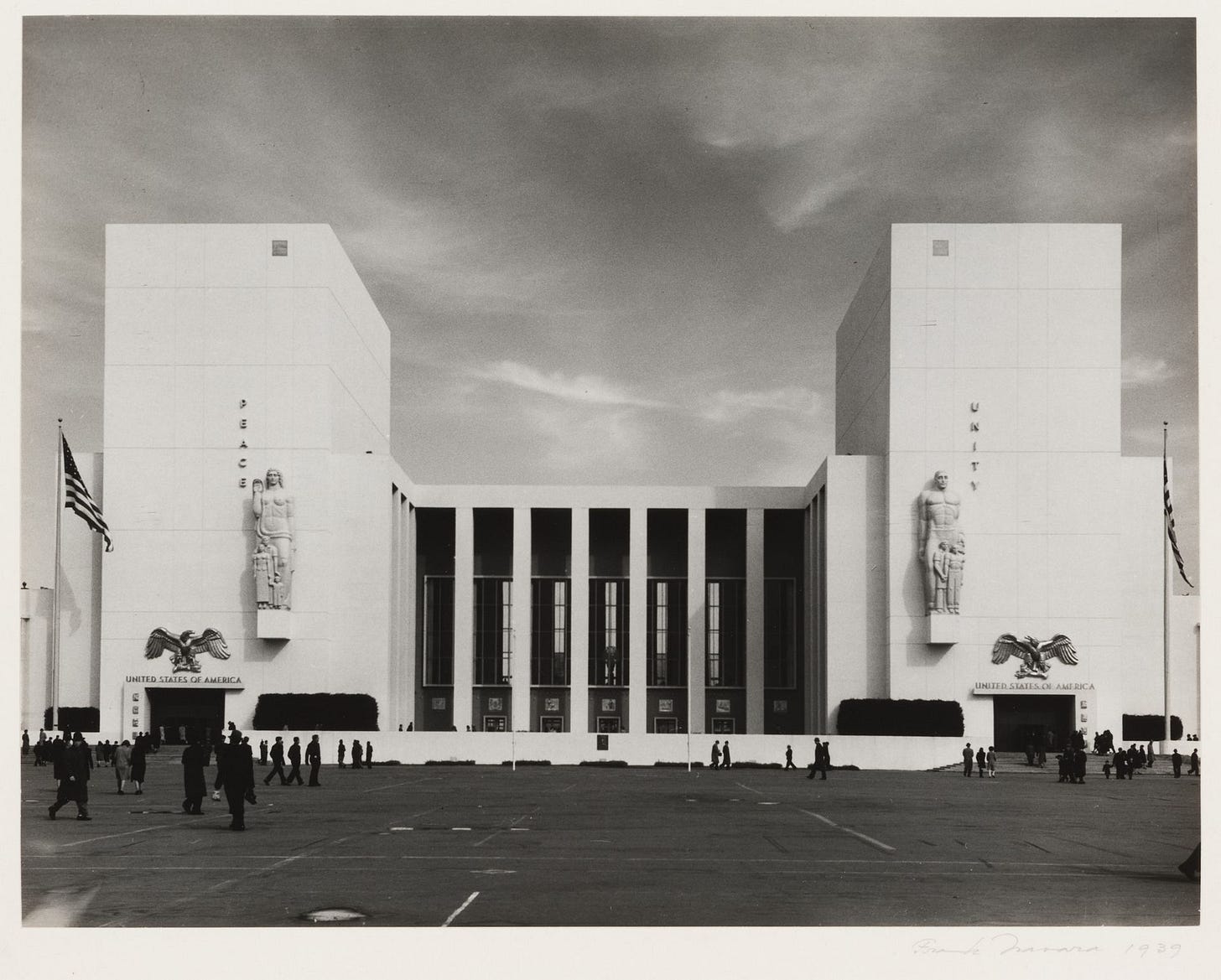

It was all so spectacular that even the otherwise boring, like new developments in the insurance industry, were dramatized with marionette shows. And if that didn’t suit you, you could always go see how Wonder Bread and Hostess Cakes were made in precise step-by-step detail.
The Fair had it all and promised to provide, enough so that you could live there. Forty-eight families were chosen as winners of the Fair’s “Typical American Family” contest, representing the ideal Americans for this new world. They spent a week at the Fair for free, living on the fairgrounds, enjoying all the latest amenities in “fully furnished bungalows complete with maid service.”2
So much of what would become modern America was on these fairgrounds. The American frontier—officially settled in 1912 with the admission of all the contiguous states of the Union—was moving to a new psychic plane. As the Fair demonstrated, the new untraveled frontier was now to be desire itself. A 20-minute film for the most popular exhibit at the Fair named Futurama opened by telling viewers that “the promise of distant horizons has always called men forward.” The film associated the frontier’s original, rugged roads with the new roads being forged in the mind: those untraversed desires and new ways of living that consumer society would bring.
“Men have moved on and on,” the film declared, “always to find that old horizons open the way to new horizons.”
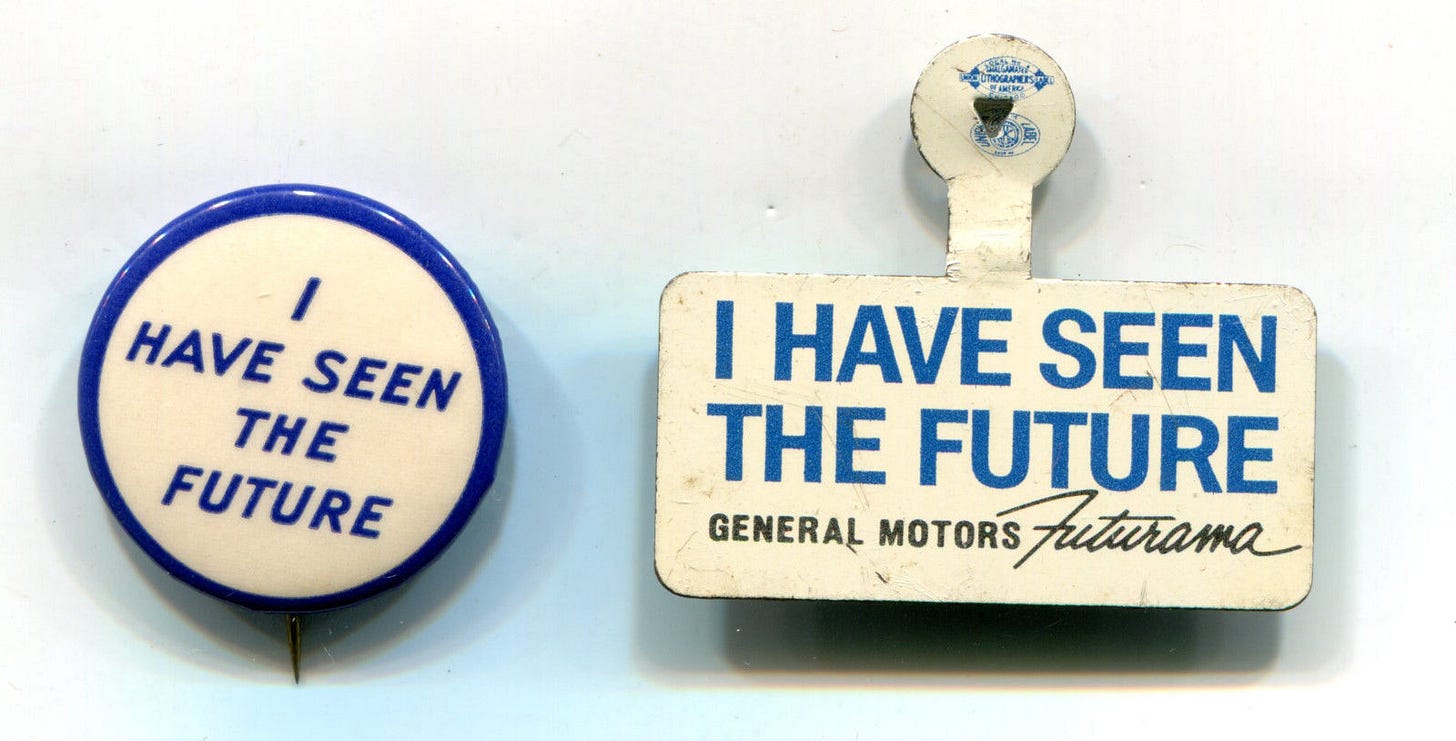
I’ve been reading quite a bit about the 1939 World’s Fair recently. My interest has been not only in the sights, as spectacular as they were, but also in the ideas they represented. Rarely do you see so much ideology and meaning condensed into one event.
I’m of the opinion that any critique of the present is best done by understanding when its justifications were at their height, optimistic and full of hubris. Arguably, the 1939 World’s Fair was that moment. Yet, our vantage point is altogether different from the Fair’s attendees. Our world is no longer like theirs, and what was dreamlike then might easily appear otherwise to us today. So rather than recount the experience of the Fair as has been often told, I would like to instead turn to what the attendees did not readily see but had great consequences for the present day.
Many of the Fair’s attendees received a pin that famously read, “I have seen the future” and, in many ways, this was right. Americans would come to inhabit that promised future, but its repercussions were poorly understood. Looking back, the 1939 World’s Fair stands as an inflection point for how the U.S. would develop, but it was as much a forewarning as it was a dream.
A New Consumer Democracy
If you were to attend the 1939 World’s Fair, you would be greeted with two structures named Trylon and Perisphere. The former was a tall, spire-like structure equipped with what was then the world’s longest escalator. The latter was a humongous sphere. These two modernist structures were the Fair’s mascots.
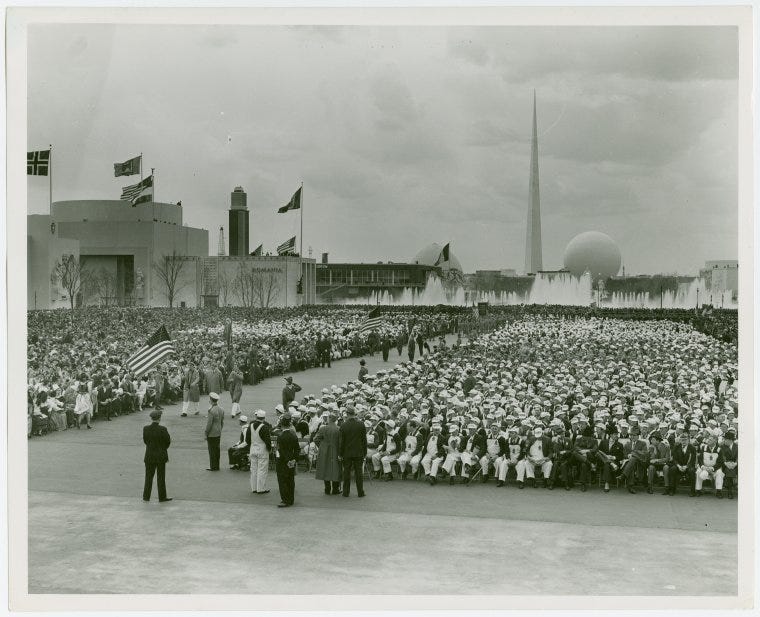

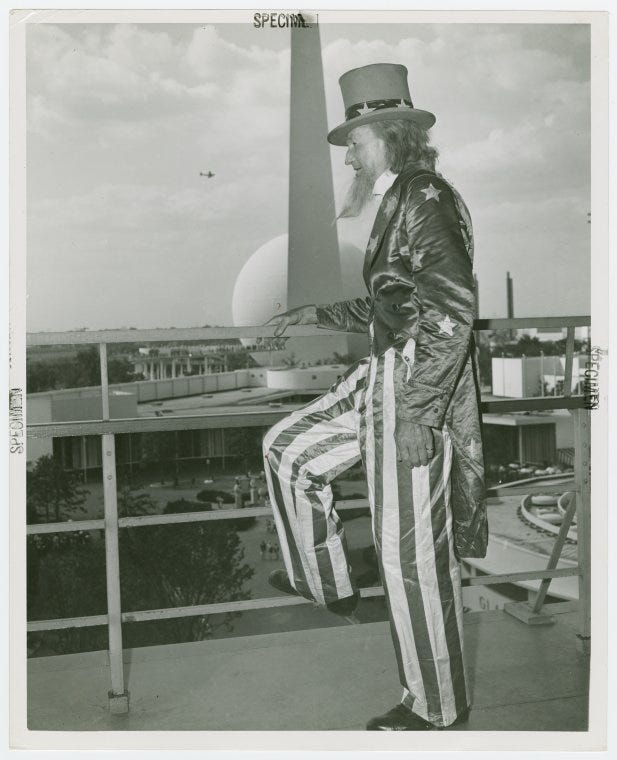
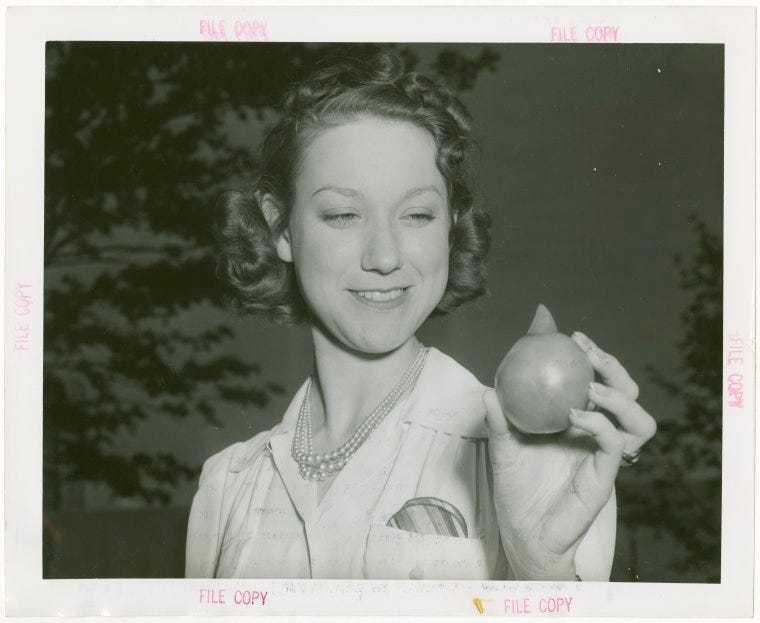
By stepping into the Peripshere, a new world would be unveiled to you. Inside, a diorama of a future utopian city was constructed called “Democracity.” It was designed to be inhabited by a million and a half people, covering 11,000 square miles.
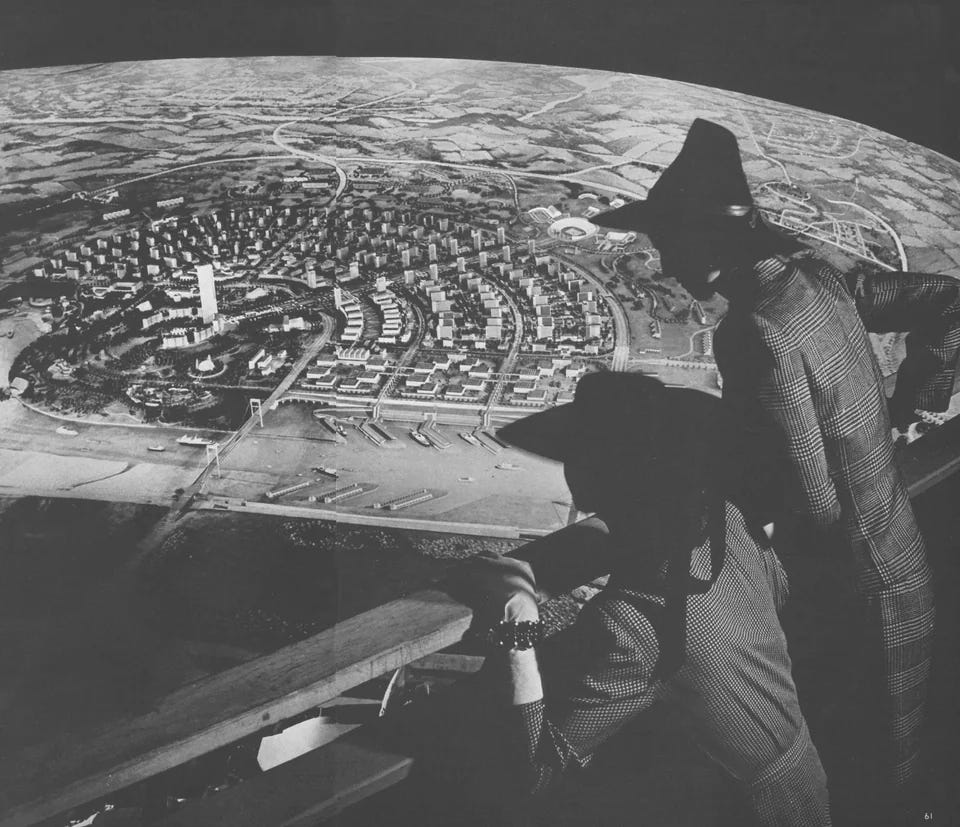
Trylon and Perisphere, along with Democracity inside, were the symbolic heart of the Fair. But the branding behind it all was intentional for more reasons than one would initially assume. The idea was created by the Fair’s publicity director, Edward Bernays. Bernays was Sigmund Freud’s nephew, known as the man chiefly responsible for bringing his psychoanalytic theories to the United States during the 1920s.
While Sigmund himself fell into despondency in Europe after World War I, Bernays became widely successful in the United States. Using ideas of the unconscious, he quickly gained a reputation as someone who could conjure up mass public opinion for products and issues like no one else. While his later critics likened it to “manipulation,” Bernays himself called it “public relations,” a term he coined.
Yet, reading his work, one finds a deeply cynical man. Bernays rationalized his activities by arguing that the management of mass desire was preferable to the alternative—that is, “letting the unconscious run wild” with its repressed urges. If these dark forces were actually unleashed, he believed, they could undo society itself. Consumerism was hence viewed as a bulwark against the primitive mind of the crowd, and managing its desires was rationalized as necessary in saving society against itself. As he stated openly in his work Propaganda (1928), “the conscious and intelligent manipulation of the organized habits and opinions of the masses is an important element in democratic society.”3 He was therefore one of the first theorists of what can be called "managed democracy."
Whether he really believed in his own rationalization or not, Bernays did become incredibly wealthy from his services. By the late 1920s, he was “living in a suite of rooms in one of New York’s most expensive hotels, where he gave frequent parties.”4 According to an employee of Bernays, the events were a “who’s who” of the business elite, the arts, media leaders, and the mayor himself.5 In due time, his clients also included those within politics and the state. He became a "sort of magician" of public opinion, even though he openly viewed this same public with open contempt.6 Given his reputation, it was unsurprising that Bernays was tapped for the 1939 New York World’s Fair.
This time, however, the project was not any particular corporate brand or political issue. Instead, Bernays was tasked with marrying two fundamental concepts that made his profession possible in the first place: consumerism and American democracy itself. This was the Fair’s stated purpose as he outlined in a speech delivered in April, 1937. The goal was to demonstrate the “relationship of private industry and private enterprise to government and to the people.” Most importantly, as was so typical of Bernays, this Fair had to openly appeal to consumer desire, which had never been done before.
Other fairs were interesting, entertaining, exciting. This Fair will be, too. But only this one will answer the question, “what does all this mean to me?”7
Given that the American public was just coming out of the Great Depression, it was known that the reputation of “big business” in the United States was at historic lows. By framing the World’s Fair through the prism of desire, Bernays sought to rehabilitate this perception by giving Americans an open door—one that they themselves did not even know they wanted. Bernays’s daughter confirms this aspiration of his in an interview with Adam Curtis for his documentary A Century of the Self (2002).
Anna Bernays: To my father, the World’s Fair was an opportunity… Capitalism in a democracy, democracy and capitalism in marriage. It was consumerist, but at the same time you inferred in a funny way that democracy and capitalism went together.
Adam Curtis [continues]: The vision it portrayed was of a new democracy in which businesses responded to people’s innermost desires in a way politicians could never do. But it was a form of democracy that viewed people not as active citizens… but as passive consumers… [which] Bernays believed was the key to control in a mass democracy.8
As Curtis makes clear, this thinking reached its symbolic high point at the 1939 World’s Fair. A democratic vision was then constructed by its very own skeptic, someone who viewed democracy as nothing other than a form of social management. Historian of public relations, Stewart Ewen, summarized this view in an interview with Adam Curtis:
It’s not that the people are in charge, but that the people’s desires are in charge. The people exercise no decision-making power within this environment. So democracy is reduced from something which assumes an active citizenry to the idea of the public as passive consumers driven primarily by instinctual or unconscious desires, and if you can trigger those needs and desires, you can get what you want from them.9
At the end of the century, the consequences of this vision would be criticized by writer Christopher Lasch. Published after his death in 1994, Lasch wondered whether American democracy was now merely living off the “borrowed capital of moral and religious traditions antedating the rise of liberalism."10 Lasch was a critic of the kind of managed democracy that began to emerge around Bernays's time. By the 1990s, the consequences had become self-evident: when Lasch was writing, civic participation had sunk to its lowest point since World War II.11
Perhaps this long trajectory—triumphantly advertised as a "new horizon" at the 1939 World’s Fair—helps explain why the state’s competency and ability to execute basic functions has deteriorated so badly in our own time. Needless to say, Bernays's model of managed democracy was not exactly resilient and built to last.
Decades later during the 1970s, optimism would dry up amid scandal as institutional trust collapsed, exposing the hollowness of this consumer model of democracy outright for the first time. The fact that the United States has still not recovered from that “crisis of confidence” is not accidental: the ultimate outcome of a Bernaysian model of managed democracy is not renewal amid crisis, but rather an entrenchment of its old managerial ways, because it has so little of an active public to draw upon.
Magical Motorways
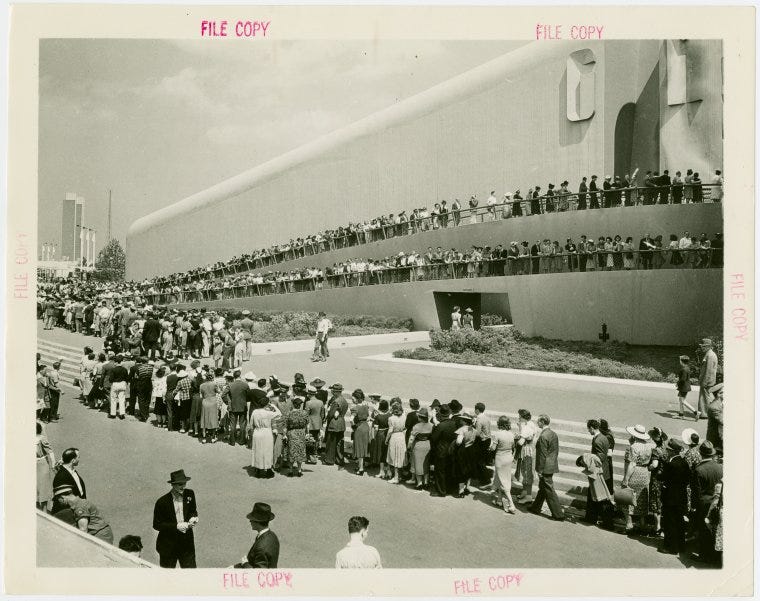
Democracity, however, was not the most popular exhibit at the 1939 World’s Fair. That title went to Futurama, a grand construction that really dazzled audiences in its day. Sponsored by General Motors and designed by Norman Bel Geddes, Futurama was an urban utopia for the automobile. The entire diorama stretched over 35,000 square feet featuring half a million buildings and houses. Its centerpiece was the “city of tomorrow” with its 14-lane highways that cut through a metropolis of skyscrapers.
The exhibit emphasized constant movement. Attendees were seated in moving chairs equipped with soundboxes that narrated the entire tour. One passed through the future countryside, mountains, industrial centers, and farm areas — culminating in the city of Futurama itself. All of this, Geddes promised, would be possible by 1960.
For many Americans, Futurama was the first glimpse of what would become the national highway system.12 Geddes privileged the multi-lane highway as the centerpiece of his urban design, the embodiment of “streamlined spaces.”
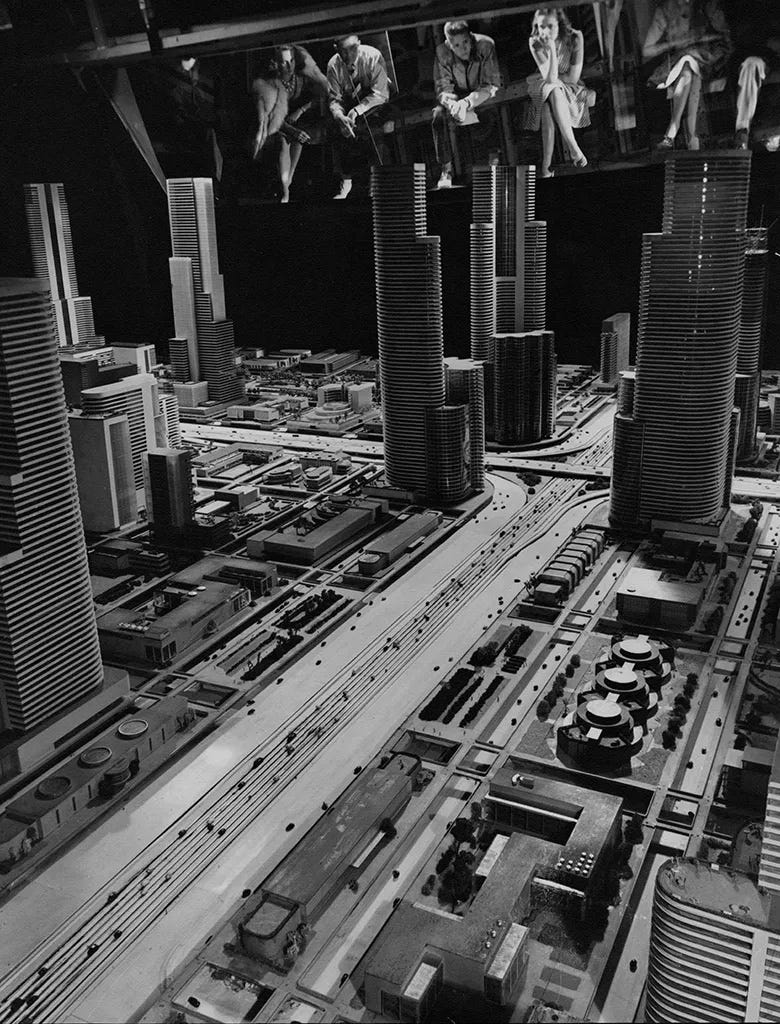

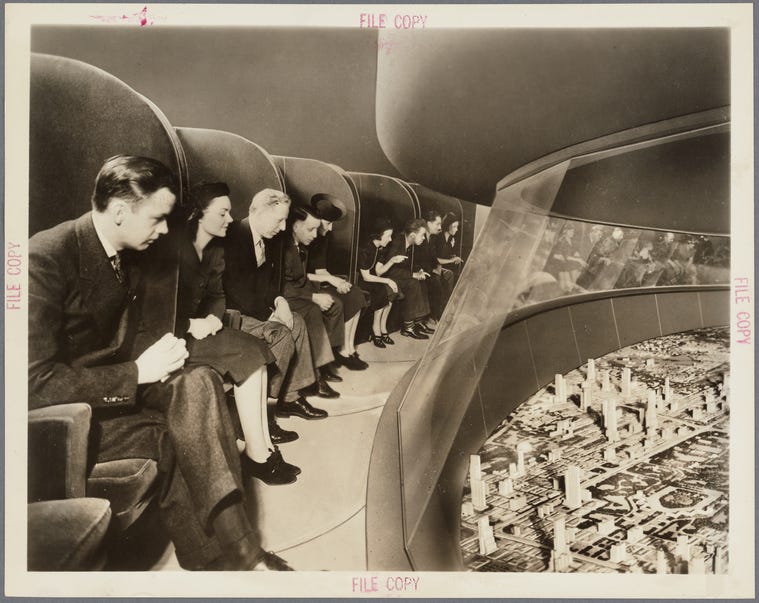
The issue was, while Futurama did excite audiences, there was not much of “them” in it. Sociability was frankly not built into its design, and this would be a troubling omen for the coming decades. In my latest piece for Palladium Magazine, I traced how a version of Futurama ultimately did become an American reality.
Planners after World War II went to work on the most expansive urban reconstruction project in the country’s history. As I documented in my essay, planners so often cut through city downtowns “as if they were shaping an inordinate and malleable mass rather than lived space.” Jane Jacobs criticized this in The Death and Life of American Cities (1961), writing that “a growing number of planners and designers have come to believe that if they can only solve the problems of traffic, they will thereby have solved the major problem of cities.” By the 1960s, local community involvement in virtually every American city pushed back against the urban highway and Geddes’s dream, but with mixed success.
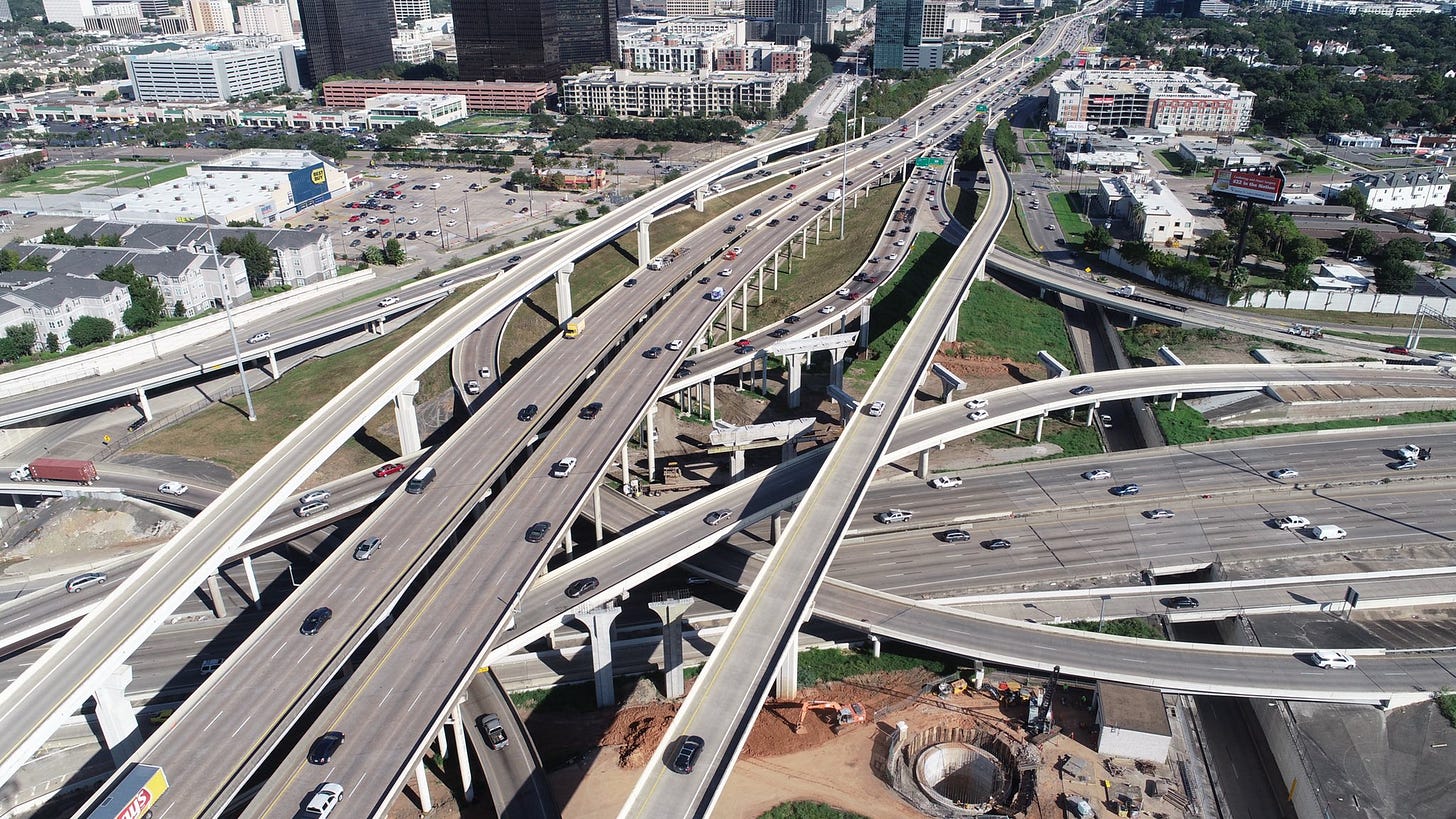
Fifty years after the Futurama exhibit, sociologist Ray Oldenburg wrote in his bestseller book The Great Good Place (1989) that “the problem of place in America has not yet been resolved.”13 He wrote of an America that had lost many of its places of belonging and meaning. Particularly, Oldenburg lamented the loss of “third places”—those places that are neither work nor home—as being responsible for the decline of America’s “informal public life.”
Last year, I wrote a widely-shared piece about the ongoing “social recession” where I documented this trend to the present day. Arguably, a line can be drawn between Geddes’s vision at the 1939 World’s Fair and our current atomized world. And it should be said that Futurama was also fitting for the kind of consumer democracy Bernays imagined. The former sought to reshape the lived space of everyday people in mechanically efficient ways, while the latter was about how this newly-passive public would be democratically managed. Both being of the same zeitgeist, the two visions complement each other.
Science in Service of Other Ends

I have so far outlined two fundamental visions that fit together, both presented at the 1939 World’s Fair. There was Bernays’s view of consumer democracy and Geddes’s dream of magic motorways. However, although they won out in the end, these were not the only ideas in contention. There was a competing view that science, not consumerism, should be wedded to democracy instead. Such ideas were actively discouraged at the planning level.
While the Fair undoubtedly presented some scientific breakthroughs, this often came secondary to the actual goals of the event. Reform-minded scientists as early as 1936 began to express worry that there was no extended section of the Fair devoted to just scientific achievement. They also wished to see science openly associated with democratic thinking. As noted informational scientist Watson Davis told audiences in 1938, “in these perilous times for so many areas of the world, we can not reaffirm too often that the scientific way is the democratic way.”14 In a highly-corporatized atmosphere that privileged branding, exhibits came to instead present science as “gadgets, commodities, and magic.”15

The belief that science was a monolith that could “save the people” may appear short-sighted to us today. Nonetheless, such ideas had widespread currency because reformers viewed the scientific worldview as equivalent to a rational and more just society. They sought to make this case clear at the 1939 World's Fair. The idea that “a fair with the stated theme of ‘Building the World of Tomorrow’ could be predicated on anything but science seemed inconceivable to many scientists.”16
Yet, despite extensive lobbying, the actual scientific footprint of the Fair was marginal compared to the Bernaysian selling of desires. The science that was presented was often done in a flashy manner, resembling more of a carnival than education. This is reflected in the reviews at the time, as Peter J. Kuznick documents in his essay Losing the World of Tomorrow (1994).
For example, Esquire wrote of the Fair’s essence as being, “its unique ability to stimulate trade and commerce; its influence on style, customs, buying habits.”17 Likewise, The New Yorker describes the cultural shift of the Fair as being chiefly about replacing old buying habits with new ones, not about introducing a scientific worldview. These reviews are odd for a Fair billed as being about futuristic, technological achievement and the supposed “world of tomorrow.”
As Kuznick further documents:
Grover Whalen, a former president of the New York Advertising Club, admitted candidly to club members that, if successful, the fair "would be the advertising precipitant for the next 3 to 5 years, the sales stimulant of the decade, and the advertising agencies' own laboratory."
The New Republic editor Bruce Bliven retracted his December 1938 prediction of a democratic and visionary fair, and charged that he had been "sucked in by Mr. Whalen's publicity department," and he even dismissed the focal exhibits as a "salesman's dream of democracy.”
Apparently, in the view of corporate planners, citizens would participate in that exalted world of tomorrow not as socially conscious, scientifically grounded decision makers but as consumers within mass society.18
The sentiment that this was a “salesman’s dream of democracy,” rather than a testament to scientific achievement, was noticed among astute observers. Even Geddes’s Futurama exhibit was not spared criticism. As journalist Walter Lippmann wrote, "General Motors has spent a small fortune to convince the American public that if it wishes to enjoy the full benefit of private enterprise in motor manufacturing, it will have to rebuild its cities and its highways by public enterprise."19
If we take world fairs to be akin to a “rite of passage” for any society, we can view 1939 as a cultural event that charted a particular course. The authority of science was employed as a means toward what essentially amounted to the selling of new lifestyles. Science provided the Fair with authority, but it was in service of mass consumer ends. Because scientists and their organizations were unable to mount an effective protest, the reformist desire to associate their worldview with democracy fell apart.
Kuznick posits that this fact helps to explain why science so easily came under the helm of Cold War military-related research for grants and approval during the 1950s. In all, we can speculate on how a Fair might have looked like had it been rooted in ideas other than those of Bernays and Geddes.
The Other Fair
I’ve written this essay stylized loosely as a “tale of two Fairs,” focusing on what went largely unnoticed at the time. I’ve tried to capture another Fair that was also present then, whose possible consequences were noticed by some astute observers, but still lost in the dream. Ultimately, two fundamental visions were put forward, one by Geddes and the other by Bernays, which would reshape America thereafter.
Looking through the archives, one’s historical position clearly determines which Fair one sees. Reading contemporary comments on Geddes’s Futurama, I am always struck by the overwhelmingly negative reactions. The idea of a 14-lane mega-highway in a grid-based metropolis does not evoke much inspiration nowadays. For some, this is where it “all went wrong” regarding urban planning. Others call it excessively polluting, and the main reason why the United States does not have extensive public transit. Yet at one point, Geddes’s design was considered in line with the cutting edge of 20th-century modernism.
But at least, there were ideas. It is hard to imagine what the equivalent American Fair would be in this day and age, either due to our cynicism or because the infrastructural ability to build is simply no longer there. High modernism was reliant on grand national narratives told to an eager public. Having lost this sense of the future today, it’s no wonder the 1939 World’s Fair feels like a portal to a lost world, one that nonetheless made ours.
For a full glossary of everything at the Fair, check out this website.
Edward Bernays. Propaganda (Ig Publishing: 2004), pg. 37.
https://elaineou.com/wp-content/uploads/2022/01/20160219cpy..-Century-of-the-Self-Transcript-4-part-film-series-by-A.Curtis-55p.pdf, pg. 8.
As documented in Adam Curtis’s four-part documentary Century of the Self (2002). Transcript here.
Edward Bernays’s daughter openly says that he viewed people with contempt. She says, “People who worked for him were stupid. Children were stupid. And if people did things in a way that he didn’t, he wouldn’t have done them. They were stupid. That was it. It was a word that he used over and over and over. Dope and stupid.” ”And the masses?” “They were stupid.”
Quoted from Century of the Self (2002).
Quoted from Century of the Self (2002).
Christopher Lasch. Revolt of the Elites (1995), pg. 81.
Ray Oldenburg, The Great Good Place (1989), pg. 10.
Peter J. Kuznick. “Losing the World of Tomorrow: The Battle Over the Presentation of Science at the 1939 World’s Fair.” American Quarterly, Sept. 1994. pg. 347.
Ibid., pg. 341
Ibid., pg. 341
Ibid., pg. 363
Ibid.
Ibid., pg. 364



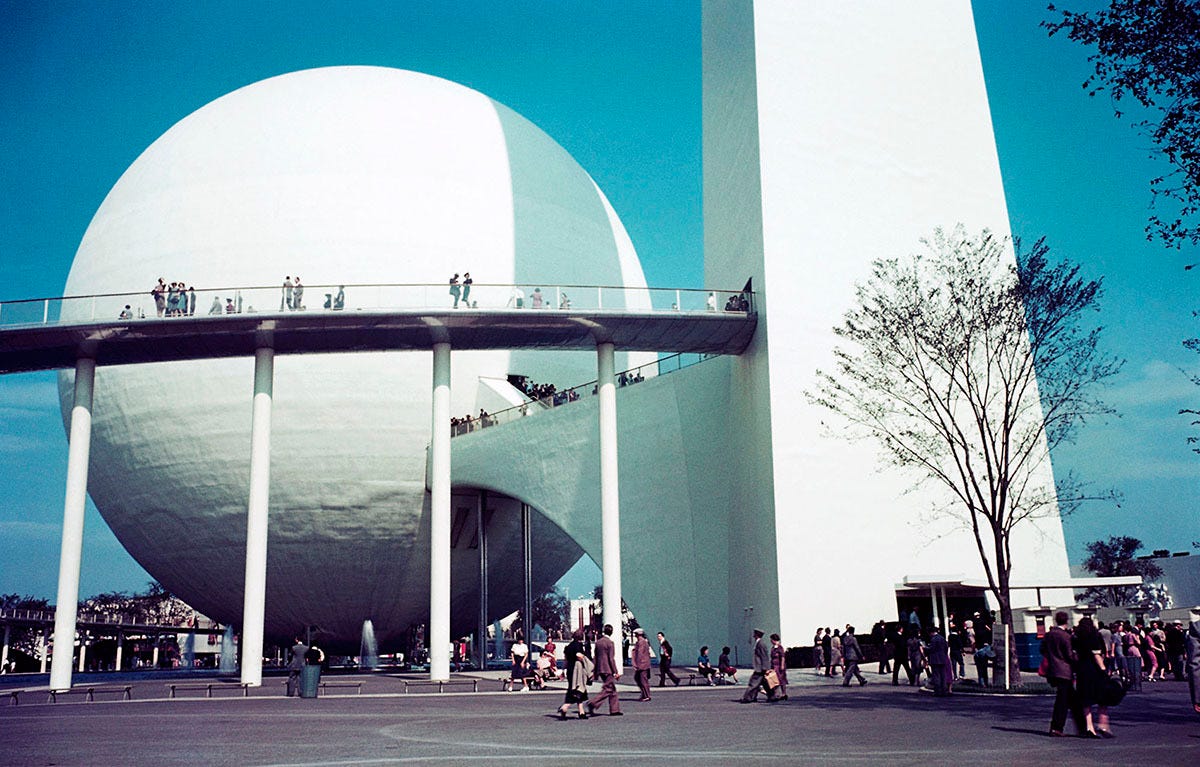
This was a good piece. Other commenters have mentioned that the US was preparing to fight fascism at this time, but I don't really think that's true. This happened in 1939 and the imperative (and you could argue, popular mandate/support) to get involved in the war really didn't happen until almost 1942 (Pearl Harbor was 12/7/1941).
My take on this is that the intelligentsia at this time realized that promoting mass consumerism was the only real way forward for them to maintain control of the United States. 1939 was still very much a time in which the Great Depression's effects were being felt. Think, for example, of how much the Great Recession still resonated in popular debate in 2017 and 2018. 1939 was the same amount of time away from the Great Depression as those years were for us.
Consumerism, and by extension, control, has thus been used as a primary form of control ever since. Frankly, it makes sense because we're a nation with arguably very little shared history and ethnic ties; the alternative power structures probably look very different, and maybe even less peaceful than they are right now.
The real takeaway for me from reading about this fair is that it's cool to see how people in this time were actively thinking about how the future could be reimagined, different, and potentially better than the present. Look at the design quality that went into some of these exhibits. Have you seen art or design that has struck you the way that it probably struck those in attendance then? I rarely have. Especially not design that was made in the present day.
The future that was presented at the fair may not have been a future everyone wanted, but at least they were attempting to imagine something. I want to see that imagination make a comeback in our society today.
This was very well written, informative. I am so glad I stumbled across this site. Keep up the good work Anton!